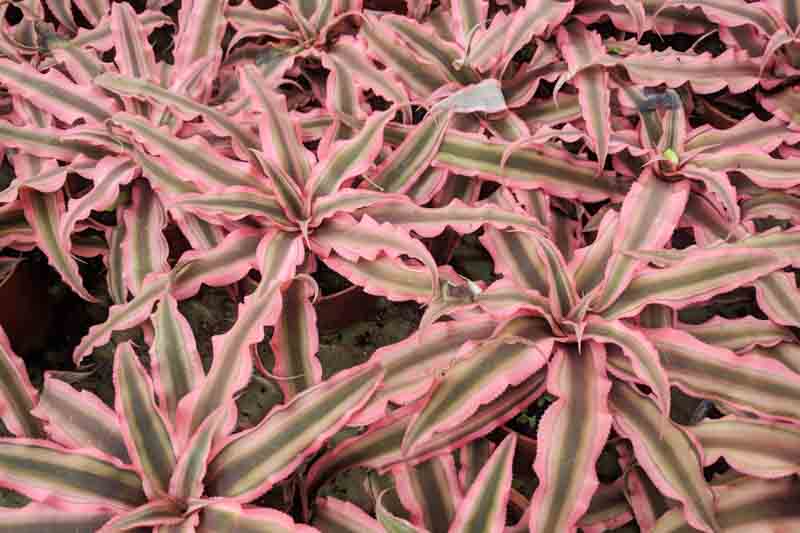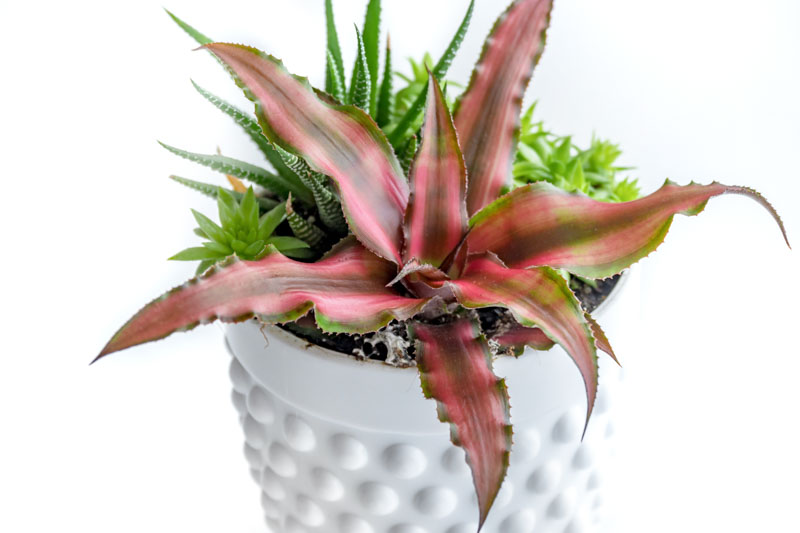Dwarf Rose-Stripe Star, Earth Star, Earth Star Bromeliad, Green Earth Star, Pink Starlite, Red Star Bromeliad, Starfish Plant, Star Plant
Cryptanthus bivittatus, commonly known as Earth Star due to its unique star-shaped arrangement of leaves, is a fascinating plant that brings an exotic touch to any indoor garden.
Cryptanthus bivittatus is characterized by its striking, rosette-forming leaves that spread outward in a star-like pattern. The leaves are typically banded with contrasting colors, ranging from green and pink to deep reds, depending on the variety and environmental conditions.
Native: This plant is native to Brazil, where it thrives in the warm, humid conditions of tropical rainforests. It often grows as an epiphyte on trees. Cryptanthus belongs to the bromeliad family (Bromeliaceae), which includes around 3,700 known species across approximately 80 genera. Popular genera include Aechmea, Guzmania, Tillandsia (air plants), Vriesea, and Neoregelia, each known for their unique decorative qualities.
Plant Type and Habit: The Earth Star is a stemless bromeliad forming a compact, low-growing, spreading rosette.
Size: The Earth Star is a modestly sized plant, typically reaching 6 inches (15 cm) in height and 12 inches in spread. Its compact size makes it ideal for indoor cultivation.
Flowers: The flowers are small and white, appearing in the center of the rosette. While they are not particularly showy, they add a subtle charm to the plant’s overall appearance. This tropical plant blooms sporadically throughout the year, with no specific bloom time. The plant blooms once in its lifetime and then dies. However, it produces offsets, ensuring its legacy and contributing to its role as a stunning ground cover.
Foliage: The foliage is the most striking feature, with stiff, spiny, wavy, strap-like leaves adorned with beautiful stripes or mottling. The color intensity can vary dramatically with light exposure.
Hardiness: If planted outdoors, this bromeliad is best suited for USDA hardiness zones 9-11. It thrives in warm, humid environments but can also be grown indoors in cooler climates.
Award: Recipient of the prestigious Award of Garden Merit of the Royal Horticultural Society.
Uses: This bromeliad is primarily used as an ornamental plant. It’s well-suited for terrariums, dish gardens, and as a decorative indoor plant. It can be used in shaded rock gardens or as underplanting in humid, shaded areas in tropical climates.
Toxicity: Cryptanthus bivittatus is not known to be toxic to humans or pets. This makes it a safe choice for households with children and animals.
Drought: While it prefers consistent moisture, Cryptanthus bivittatus can tolerate short periods of drought. Its succulent-like leaves store water, allowing it to withstand temporary dry conditions.
Invasiveness: Cryptanthus bivittatus is not considered invasive. Its slow growth rate and specific habitat preferences limit its spread in non-native environments.
Benefits: The primary benefits of Cryptanthus bivittatus are its ornamental value and ease of care. It can enhance indoor air quality by releasing oxygen and increasing humidity, contributing to a healthier indoor environment.

Growing and caring for the Earth Star (Cryptanthus bivittatus) offers a unique opportunity to bring a touch of exotic beauty both indoors and outdoors.
Light: Earth Stars thrive in bright, indirect light. A spot near a window that gets filtered sunlight is ideal. Direct sun can scorch its leaves, while too little light can fade the vibrant colors.
Watering: Keep the soil consistently moist but not waterlogged. Water when the top inch of soil feels dry to the touch. These plants are sensitive to chlorine and other chemicals in tap water, so use rainwater or distilled water when possible.
Humidity: They appreciate high humidity, which is typical of their native tropical environment. To increase humidity, place the plant on a water-filled pebble tray or use a humidifier, especially in dry indoor climates.
Temperature: Maintain indoor temperatures between 60-80°F (15-27°C). Avoid placing your Earth Star near drafty windows or vents where it might experience sudden temperature changes.
Soil: Use a well-draining potting mix. A mixture designed for orchids or bromeliads, which typically includes bark and perlite, works well.
Fertilization: Fertilize lightly during the growing season (spring through summer) with a half-strength, balanced liquid fertilizer about once a month. Over-fertilization can harm the plant.
Repotting: Earth Stars do not require frequent repotting due to their slow growth. Repot only when the plant outgrows its container, usually every 2-3 years.
Location: Plant in a shaded or partially shaded spot. Direct sunlight can damage the leaves. They can be grown in the ground in a shady garden spot or in containers.
Soil: Ensure the soil is rich and well-draining. Amend garden soil with organic matter to improve drainage and texture.
Watering: Outdoor plants may require more frequent watering than indoor ones, especially during hot, dry periods. Monitor soil moisture regularly and water when the top inch becomes dry.
Mulching: Apply a layer of organic mulch around the base of the plant to help retain soil moisture and regulate temperature.
Temperature: Earth Stars are not frost-tolerant. If temperatures drop below 60°F (15°C), consider bringing container plants indoors or provide protection for garden plants.
Fertilization: Like indoor plants, fertilize outdoor Earth Stars sparingly. A slow-release fertilizer applied in early spring can support growth without overwhelming the plant.

Propagating Earth Star is a straightforward process that allows you to multiply your collection and share this beautiful plant with friends and family. Earth Stars produce offsets, also known as “pups,” which can be separated from the parent plant and grown individually. Here’s how to propagate Earth Star successfully:
Timing: The best time to propagate Earth Stars is during the spring or early summer, which gives the new plants ample time to establish themselves in the warmer months.
Identifying Pups: Pups are small replicas of the parent plant that grow from its base. Wait until these offsets are about one-third to half the size of the parent plant, as this ensures they have developed their own root systems, making them more likely to survive when separated.
Gently Remove the Parent Plant: Carefully take the parent plant out of its pot to better access the pups. This minimizes damage to both the parent plant and the offsets.
Separate the Pups: Cut the pups from the parent plant with clean, sharp scissors or a knife. Make sure each pup has its own roots. If the pup doesn’t separate easily, check if you can gently pull it apart from the parent plant using your fingers, which might be preferable to avoid damage.
Allow to Callous: Place the separated pups in a dry, shaded area for a day or two. This allows the cut area to callous over, reducing the risk of rot when planted.
Prepare Pots: Fill small pots with a well-draining soil mix similar to what the parent plant was growing in. A mixture of peat, sand, and perlite is often recommended for Earth Stars.
Plant the Pups: Plant each pup in its own pot, burying it up to the base of its leaves. Firm the soil around the base to support the plant.
Watering: After planting, water lightly to settle the soil around the roots. Maintain the soil lightly moist but not waterlogged to encourage root growth without causing rot.
Location: Place the pots in a location where they receive bright, indirect light. Avoid direct sunlight, which can scorch young plants.
First Few Weeks: Monitor the pups closely for the first few weeks, adjusting watering as needed to keep the soil moist. The pups should start showing new growth in a few weeks to a month, indicating they have successfully established.
Long-Term Care: Once established, care for the young Earth Stars as you would the parent plant, adjusting as necessary for their smaller size initially.
Earth Star plants, with their striking appearance, can sometimes be challenged by pests, diseases, and other common problems.
Spider mites: Tiny and often red or brown, spider mites create fine webs on the plant. They thrive in dry conditions and can cause the leaves to become speckled and faded.
Mealybugs: These pests appear as tiny, white, cotton-like masses on the leaves and stems, feeding on the plant’s sap. They can cause stunted growth and leaf discoloration.
Scale insects: These appear as small, brown, dome-shaped bumps on the leaves and stems. Like mealybugs, they suck sap from the plant, weakening it.
Root rot: Overwatering is the most common cause of root rot in Earth Stars. Symptoms include yellowing leaves, wilting, and a mushy base. Well-draining soil and careful watering can prevent this issue.
Leaf spot: Caused by fungal or bacterial pathogens, leaf spot appears as discolored, often brown or black, spots on the leaves. Ensuring good air circulation and avoiding wetting the leaves when watering can help prevent this problem.
Leaf Burn: Direct sunlight can scorch the leaves of an Earth Star, turning them brown and crispy. These plants prefer bright, indirect light.
Fading Color: Insufficient light can lead to the loss of the vibrant leaf colors characteristic of Cryptanthus bivittatus. If the plant’s color fades, try moving it to a brighter location.
Poor Growth: Lack of nutrients can lead to poor growth. However, Earth Stars require minimal fertilization. Feeding them with a diluted, balanced fertilizer once or twice during the growing season can help.

The vibrant colors of an Earth Star (Cryptanthus bivittatus) can fade for a few reasons, primarily related to light exposure. If your Earth Star is losing its vivid colors or turning green, it may not receive enough light. These plants prefer bright, indirect light to maintain their colorful foliage. Too little light can cause them to revert to a more green coloration, which is their natural state without strong light. Conversely, too much direct sunlight can fade colors and scorched leaves. Finding the right balance of light is key to keeping your Earth Star’s colors bright and vivid.
Watering frequency for Earth Stars depends on various factors, including the plant’s environment, the season, and the potting mix’s moisture retention. As a general guideline, allow the top inch of the soil to dry out before watering again. This might mean watering approximately once a week, but adjusting based on your specific conditions is essential. In winter, when the plant’s growth slows down, you can reduce watering frequency. Remember, Earth Stars prefer a humid environment but do not like to sit in waterlogged soil, so ensure good drainage to prevent root rot.
Earth Stars are not known to be toxic to dogs or other pets. They are considered safe for households with animals. However, it’s always a good idea to discourage pets from chewing on any houseplants, as the ingestion of plant material can potentially cause gastrointestinal upset or other issues in sensitive individuals. If you have concerns or if your pet has a habit of eating plants, it’s best to keep your Earth Star and other houseplants out of reach.
| Hardiness |
9 - 11 |
|---|---|
| Plant Type | Houseplants |
| Plant Family | Bromeliaceae |
| Exposure | Partial Sun |
| Season of Interest |
Spring (Early, Mid, Late) Summer (Early, Mid, Late) Fall Winter |
| Height |
4" - 6" (10cm - 15cm) |
| Spread |
6" - 1' (15cm - 30cm) |
| Spacing | 12" (30cm) |
| Maintenance | Low |
| Water Needs | Average |
| Soil Type | Loam, Sand |
| Soil pH | Acid |
| Soil Drainage | Moist but Well-Drained |
| Characteristics | Showy, Evergreen, Plant of Merit |
| Tolerance | Drought |
| Garden Uses | Ground Covers, Patio And Containers |
| Garden Styles | Gravel and Rock Garden |
| Hardiness |
9 - 11 |
|---|---|
| Plant Type | Houseplants |
| Plant Family | Bromeliaceae |
| Exposure | Partial Sun |
| Season of Interest |
Spring (Early, Mid, Late) Summer (Early, Mid, Late) Fall Winter |
| Height |
4" - 6" (10cm - 15cm) |
| Spread |
6" - 1' (15cm - 30cm) |
| Spacing | 12" (30cm) |
| Maintenance | Low |
| Water Needs | Average |
| Soil Type | Loam, Sand |
| Soil pH | Acid |
| Soil Drainage | Moist but Well-Drained |
| Characteristics | Showy, Evergreen, Plant of Merit |
| Tolerance | Drought |
| Garden Uses | Ground Covers, Patio And Containers |
| Garden Styles | Gravel and Rock Garden |
How many Cryptanthus bivittatus (Earth Star) do I need for my garden?
| Plant | Quantity | |
|---|---|---|
| Cryptanthus bivittatus (Earth Star) | N/A | Buy Plants |
Create a membership account to save your garden designs and to view them on any device.
Becoming a contributing member of Gardenia is easy and can be done in just a few minutes. If you provide us with your name, email address and the payment of a modest $25 annual membership fee, you will become a full member, enabling you to design and save up to 25 of your garden design ideas.
Join now and start creating your dream garden!
Create a membership account to save your garden designs and to view them on any device.
Becoming a contributing member of Gardenia is easy and can be done in just a few minutes. If you provide us with your name, email address and the payment of a modest $25 annual membership fee, you will become a full member, enabling you to design and save up to 25 of your garden design ideas.
Join now and start creating your dream garden!